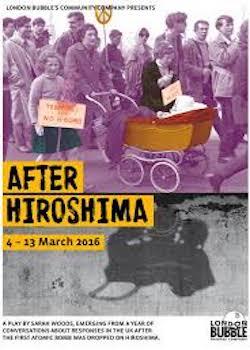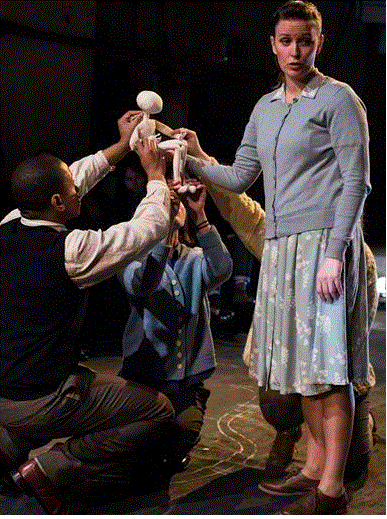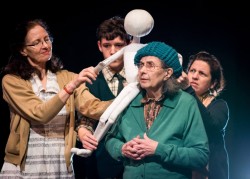London Bubble Theatre Company’s After Hiroshima: A Post-Event Reflection

London Bubble Theatre Company
Dilston Grove
3–11 March 2016
Review by Annabelle Sami
London Bubble Theatre Company, based in Rotherhithe, has formed a close relationship with Hiroshima over the past two years. This began with their intergenerational community theatre project Grandchildren of Hiroshima, which was performed in Hiroshima in collaboration with three young Japanese directors in August 2015 to commemorate the 70th anniversary of the dropping of the A bomb. Grandchildren of Hiroshima was created from the testimonials of hibakusha and performed by a cast of children, adults and grandparents. The piece was recently screened at Daiwa Foundation Japan House and is available to watch in full here:https://youtu.be/q1TdMLVh15E.
A year later, in March 2016, London Bubble performed their latest show, After Hiroshima. As a sister piece to Grandchildren of Hiroshima it tracked the British response to the dropping of the atomic bomb and the subsequent rise of pacifist groups in the UK. The show charts how reports of radiation sickness were kept hidden in the UK and how, when this information was uncovered, church leaders, young mothers, and politicians alike gathered together to protest against nuclear weaponry.
At the beginning of After Hiroshima British soldiers come across the ruined city, four months after the dropping of the bomb. One soldier recounts the harrowing experience, of the shadows burnt into the ground and of the incessant cremations. From here, the show tracks forward, through the formation of the Campaign for Nuclear Disarmament (CND) and the Aldermaston March, to the present day, with explorations of what the £100 billion cost of replacing Trident could be used for in the UK instead of nuclear warheads. The entire script is formed of testimonies from people who were involved in these early anti-nuclear protests and their memories of the news of the first atomic bombings.
The show ends with a depiction of real-life protester Takako Barker, who travels to the Japanese embassy in London every week to protest against the revision of Japan’s Article 9. A cast member then tells the story of Sadako Sasaki, the 12 year old girl who died from Leukaemia caused by radiation exposure in 1955 after attempting to fold one thousand origami cranes as a way of wishing for good health. As the story is being told the cast bring origami cranes onto the stage – a moving end to the piece.
Crucially, the cast is made up of around 40 volunteer performers from the local community, led by the artistic team at London Bubble. There was also a small team of volunteers, of which I was part, who helped backstage and at rehearsals. Some cast members are Japanese living in London (indeed, one member is from Hiroshima) and some of the cast are London Bubble regulars. Other cast members are involved in the CND or participated in peace protests in their youth. What stood out to me was the high level of all-round participation and the eagerness of the non-professional cast to play an active role in shaping the show. Their opinions and suggestions were listened to by the artistic team and this produced an overwhelming feeling of shared responsibility for the resulting show. This is something that is obviously important to London Bubble and is cultivated by artistic director Jonathon Petherbridge’s methodology. In workshops, performance material is gathered and explored with groups of community volunteers – a process that was also used in Grandchildren of Hiroshima, allowing the cast to have a say as to what goes into the show.
Helping to run these rehearsals was Yorie Akiba, a visiting artist from Tokyo and artistic director of Glasio Bluo, a Tokyo-based puppetry company. Akiba also worked on the Grandchildren of Hiroshima project, bringing a sense of unity to the two shows. She said of the performance making process,
Although the theatre making process I am experiencing here is very challenging as rehearsal hours are extremely limited, I do enjoy collaborating with other artists and actors as they are open to throw ideas and thoughts around. This kind of collaboration process was rather new to me and I will definitely apply it to my upcoming puppet project, The Talking Stick, in Hiroshima next year.
The final image in After Hiroshima is that of a British solider and Takako Barker holding an origami crane together, symbolising the shared responsibility of both countries to maintain peace. I believe it is also an encapsulation of how successful the project was in demonstrating how the arts can be used to strengthen relationships between Japan and the UK. One cast member said,
Having been to Japan, taking part in this play served to deepen my understanding of the trauma experienced by those caught in the aftermaths of the atomic blasts, but also that the tragic events have a legacy of peace and solidarity.
Not only did those involved in the project learn from the experience, with a few teenage members having never heard of Hiroshima before, they gained a new connection to the country, with many members expressing their wish to visit the Peace Memorial Museum. They also learnt about pre-existing connections between Japan and the UK of which many weren’t previously aware. Let us hope that more theatre projects can facilitate new links between Japan and the UK in the future.
www.londonbubble.org.uk
www.glasiobluo.info

